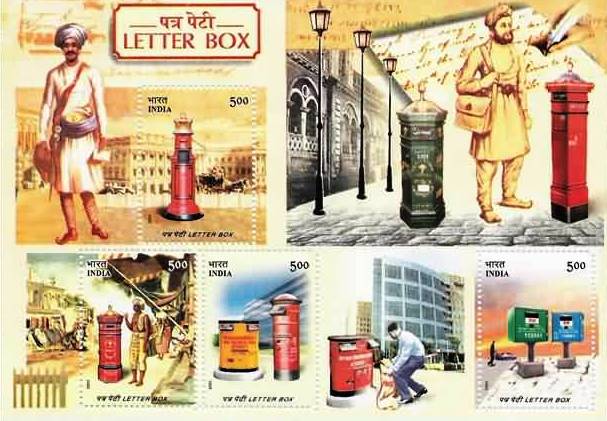One
of the most enduring symbols of India as a nation is the post man who
makes his daily round, come rain or shine. The famous Malayalam humour writer Gopalakrishnan,
who had a long and meritorious service in the Railways, as well as Kerala’s
former Chief Election Officer T N Jayachandran have written that the first person they befriend on being transferred to
a new place is the post man! Such is the friendliness and charm
of the postal service – one of the most people friendly and accessible of the
Government services.



For more than 150 years, the Department
of Posts (DoP) has been the backbone of the country’s communication and has
played a crucial role in the country’s socio-economic development.
- It touches the lives of Indian citizens in many ways: delivering mails, accepting deposits under Small Savings Schemes, providing life insurance cover under Postal Life Insurance (PLI) and Rural Postal Life Insurance (RPLI) and providing retail services like bill collection, sale of forms, etc.
- The
Department of Posts also acts as an agent for Government of India in
discharging other services for citizens such as wages disbursement of the
unique Mahatma Gandhi National Rural Employment Guarantee Scheme (MGNREGS)
as well as various old age pension payments.
The
Mission Statement of the Postal department says explicitly that the department
will maintain its iconic status as a unique and trusted national institution by
always providing the human touch in all our interactions with society, being responsive and
reliable, demonstrating the highest order of integrity, honesty, transparency
and professionalism and discharging our responsibilities towards the society in
an environment of deep trust, mutual respect and a culture of service before
self.
The latest figures say that there are 1,55, 515 post offices in
the country. Of this 1,39,040 (89.78 percent) are in rural areas and 15,826 (10.22
percent) are in urban areas. This
figure includes 25,464 departmental post offices and 1,29,402 extra-departmental
branch post offices. At the time of Independence, there were 23,344 post
offices. Moreover, these post offices were mainly in urban areas. The figures
show that the network has increased by six times after Independence, with the focus
primarily on rural areas.
 |
On an average, a post office serves an area of 21.23 square
kilometres (8.20 sq mi) and a population of 7,114. This could well
make the Indian Postal System the most widely distributed
postal system in the World.
Because of this mind boggling reach and the
ubiquitous presence in remote areas, the Indian postal service is close to
people and the people are close to the postal services!
As far as available records show, by 1861, there were 889 post
offices in India. The system was handling nearly 43 million letters and
over 4.5 million newspapers annually. It has to be remembered that the
administration was taken over by the British government from the East India
Company in 1858.
 |
The establishment of the modern postal system in India can be
traced back to the second half of the 18th century. For the facility of prepayment of postage on letters, 'Copper
Tickets' , pre-paid token stamps in 2 annavalue were introduced from Patna
in 1774 by the East India Company during the period of Warren Hastings, the
then Governor General of India.
The postal system, established by Lord Clive in the year 1766,
was further developed by Warren Hastings by establishing the Calcutta G.P.O.
under a Postmaster General in the year 1774. Postal Service was open to the
public for the first time.
The first superintendent of the post office was appointed in
1870 and he was based in Allahabad.
At present, the Department of Posts comes under
the Ministry of Communications and Information Technology. The
Postal Service Board, the apex management body of the Department, comprises the
Chairman and six Members. The Joint Secretary and Financial Advisor to the
Department is a permanent invitee to the Board. The Board is assisted by a
senior staff officer of the Directorate as Secretary to the Board. Deputy
Directors General, Directors and Assistant Directors General provide the
necessary functional support for the Board at the Headquarters.
The world's first official airmail flight took place in India on
18 February 1911, a journey of 18 kilometres (11 mi) lasting 27 minutes.
Henri Piquet, a French pilot, carried about 15 kilograms of mail (approximately
6,000 letters and cards) across the river Ganga from Allahabad
to Naini. The mail thus carries is said to have included a letter
addressed to King George the Fifth.
The first floating post office was inaugurated in August 2011
at DalLake in Srinagar, Kashmir.
The first adhesive postage stamps in Asia were issued in the
Indian district of Scinde in July 1852 by the then chief commissioner of the
region. The Scinde stamps became
known as Scinde Dawks", dawk being the English spelling of
the Hindi word Dak or (post). These stamps, with a value of 1⁄2-anna, were in use until
June 1866.
The first all-India stamps were issued on 1 October 1854.
At present, the postal department is under the process of
finalizing its IT enablement project. Trends
such as urbanisation, increased demand for financial services, increased
funding by the government for the weaker sections and the rural sector, have
opened up new opportunities for the Department of Posts. This has made
necessary the development of new processes and supporting technology.
The department is also faced with twin challenges of increasing
competition and continuing advances in communication technology, especially in
mobile telephony and the Internet. In order to provide the best-in-class
customer service, deliver new services and improve operational efficiencies,
the Department of Posts has undertaken an end to end IT Modernization project
to equip itself with requisite modern tools and technologies.
 |
The project, intends to achieve wider reach to the Indian populace
through more customer interaction channels, better customer service, growth
through new lines of business and enhanced IT enablement of business processes.
============================================================
The postal identity card is a
service offered by the postal department under clause 63 of the postal guide.
 |
The card is basically meant for the benefit
of tourists, traveling representatives of firms and other members of the public
who experience difficulty in establishing their identity in connection with
postal transactions, e.g., receipt of
registered and insured articles and payment of money orders in the post town
through which they pass. These cards will be obtainable at any head post office
by literate persons whose identity is well established in the locality in which
they reside or who can be vouched for by substantial permanent residents known
to the postmaster.
The
card will contain a full description of its holder, his signature and
photograph and will be current for a period of three years from the date of
issue. After the expiry of the period of validity of the card, a fresh card
will have to be applied for.
The use of these cards is entirely optional. Holders will ordinarily receive delivery of postal articles and payment of money orders on their presentation but in cases of doubt it will be open to postmasters to make such further enquiry as they may consider necessary to establish the identity of the applicants.
The use of these cards is entirely optional. Holders will ordinarily receive delivery of postal articles and payment of money orders on their presentation but in cases of doubt it will be open to postmasters to make such further enquiry as they may consider necessary to establish the identity of the applicants.
The cost of application for the card is Rs 20 and the card itself
will cost Rs 250. In order to make the
cards more attractive, they are being issued in the form of plastic cards like
smart cards incorporating information like date of birth, telephone/mobile
number and blood group in addition to the address of the person.
(PIB Features.)
*******
National Postal Week -- 9th to 15th October.

